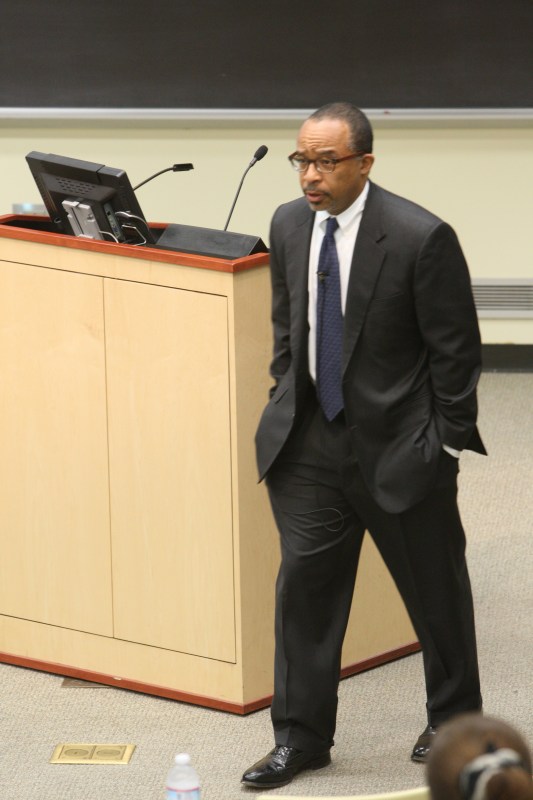
Michael DeBaun, M.D., MPH, at last week’s Discovery Lecture. (photo by Steve Green)
DeBaun outlines one-two punch of sickle cell, asthma
At his Discovery Lecture last week, Vanderbilt’s Michael DeBaun, M.D., MPH, detailed his process of research — from bedside to bench and back to the clinic — into the unique considerations of patients with sickle cell disease and asthma.
Sickle cell disease (SCD) is the most common genetic disease screened for in newborns, and occurs in one in 2,400 births in the United States. It disproportionately affects the African-American population, occurring in one in 400 births in individuals of African descent.
The story is similar for asthma, which affects about 20 percent of African-American children. The two diseases often occur together; asthma affects about 20 percent of individuals with SCD.
His interest in this area began while he was at Washington University. DeBaun saw an 11-year-old male patient with SCD and asthma who complained of diffuse pain for several weeks that did not respond to pain medication.
This single patient spawned a long journey to address questions about whether children with SCD and asthma are more likely to develop acute chest syndrome, a common complication of SCD that is also one of the most common causes of death for these patients.
Through retrospective studies (medical chart review), DeBaun and colleagues found that 35 percent of children with SCD and hospitalized for acute chest syndrome had a previous diagnosis of asthma. Prospective studies showed that asthma was associated with pain and acute chest syndrome in children with SCD — and that 80 percent of children with asthma and SCD have their first episode of acute chest syndrome by age 4.
“Clearly there’s something about this patient population that we don’t understand,” DeBaun said.
A clinical researcher himself, DeBaun then turned to basic science colleagues to try to determine mechanisms behind these clinical observations, which turned up a familial association suggesting genetic or environmental factors at play.
Studies are now ongoing to determine the importance of environmental factors like tobacco smoke exposure in this syndrome.
The research is now coming full circle, with targeted intervention trials in progress.
DeBaun’s research has perhaps most importantly demonstrated the need for a team approach to treating SCD. Too often, treatment of individuals with SCD is fragmented, with a hematologist being the primary patient contact. The revelation of the importance of asthma (and other comorbid conditions and complications) in this population is informing the treatment process for sickle cell patients — especially important to DeBaun, who is director of the Vanderbilt-Meharry Center for Excellence in Sickle Cell Disease.
DeBaun, who was elected to the Institute of Medicine in 2009, is also vice chair for Clinical Research in the Department of Pediatrics and the J.C. Peterson, M.D., Chair in Pediatric Pulmonology at Vanderbilt.
For a complete schedule of the Discovery Lecture series and archived video of previous lectures, go to www.mc.vanderbilt.edu/discoveryseries.













